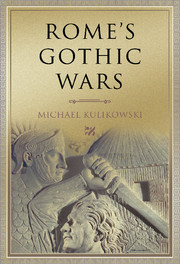Book contents
- Frontmatter
- Dedication
- Contents
- MAPS
- ACKNOWLEDGEMENTS
- Prologue BEFORE THE GATES OF ROME
- 1 THE GOTHS BEFORE CONSTANTINE
- 2 THE ROMAN EMPIRE AND BARBARIAN SOCIETY
- 3 THE SEARCH FOR GOTHIC ORIGINS
- 4 IMPERIAL POLITICS AND THE RISE OF GOTHIC POWER
- 5 GOTHS AND ROMANS, 332–376
- 6 THE BATTLE OF ADRIANOPLE
- 7 THEODOSIUS AND THE GOTHS
- 8 ALARIC AND THE SACK OF ROME
- Epilogue THE AFTERMATH OF ALARIC
- GLOSSARY OF ANCIENT SOURCES
- BIOGRAPHICAL GLOSSARY
- FURTHER READING
- NOTES
- INDEX
2 - THE ROMAN EMPIRE AND BARBARIAN SOCIETY
Published online by Cambridge University Press: 05 August 2015
- Frontmatter
- Dedication
- Contents
- MAPS
- ACKNOWLEDGEMENTS
- Prologue BEFORE THE GATES OF ROME
- 1 THE GOTHS BEFORE CONSTANTINE
- 2 THE ROMAN EMPIRE AND BARBARIAN SOCIETY
- 3 THE SEARCH FOR GOTHIC ORIGINS
- 4 IMPERIAL POLITICS AND THE RISE OF GOTHIC POWER
- 5 GOTHS AND ROMANS, 332–376
- 6 THE BATTLE OF ADRIANOPLE
- 7 THEODOSIUS AND THE GOTHS
- 8 ALARIC AND THE SACK OF ROME
- Epilogue THE AFTERMATH OF ALARIC
- GLOSSARY OF ANCIENT SOURCES
- BIOGRAPHICAL GLOSSARY
- FURTHER READING
- NOTES
- INDEX
Summary
JUST AS AN INCREASINGLY COHERENT ROMAN IDENTITY WAS spreading throughout the Roman provinces, so too were major social changes at work in the barbarian societies of northern and central Europe. Soon after the Antonine Constitution made all the inhabitants of the empire Roman citizens for the first time, a new word appears in our sources to describe the world outside the empire: barbaricum, the land of the barbarians, and the antithesis of the civilization that was synonymous – and coterminous – with the empire. The catalyst for social change in the barbaricum was the simple fact of the empire's existence and with it the growth of Roman provincial life. That fact is hardly surprising, particularly in light of modern studies showing how advanced and relatively complex societies exert unconscious pressures to change on less developed neighbours. The Roman empire was, by the standards of the ancient world, a very complex state. The sophistication of its economic life and its hierarchies of government impinged upon the peoples who lived in its shadow. As provincials became Romans, so they provided instructive models to neighbouring peoples outside the provincial structure, and offered a conduit by which the more portable aspects of Roman provincial life – from luxury goods to a monetized economy – were transmitted to lands that were not, or not yet, provincial.
We can conceive of Roman cultural influence as a series of concentric circles radiating out beyond the Roman frontier. In the band nearest to the frontier, it can sometimes be hard to distinguish the archaeological culture of the natives from their neighbours on the Roman side of the frontier, at least below the level of the social elite; indeed, the fact of imperial government and its regular demands for taxation may have been the only real factor distinguishing a Pannonian peasant on one side of the Danube from a Quadic peasant on the other.
- Type
- Chapter
- Information
- Rome's Gothic WarsFrom the Third Century to Alaric, pp. 34 - 42Publisher: Cambridge University PressPrint publication year: 2006

